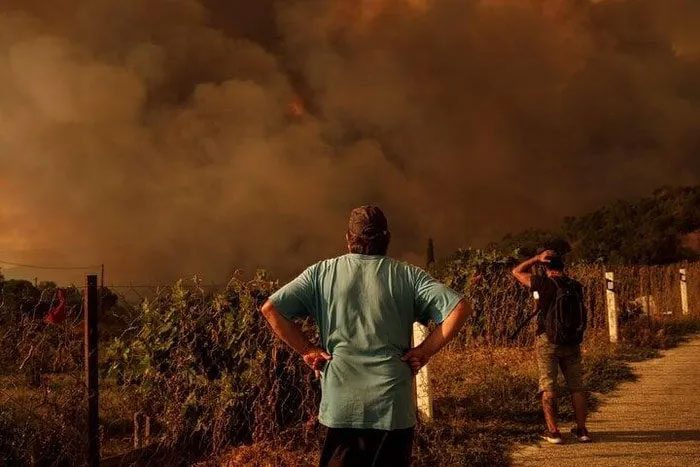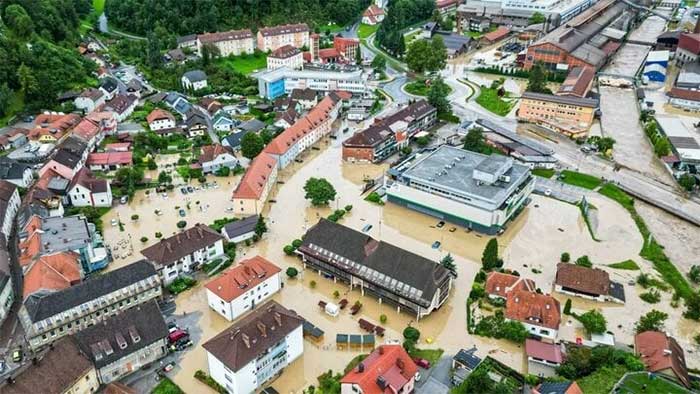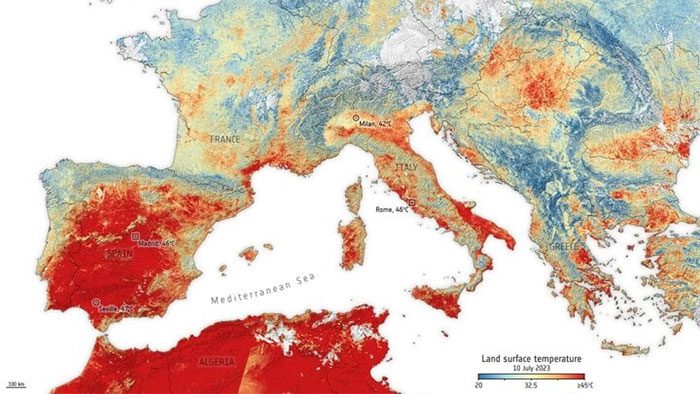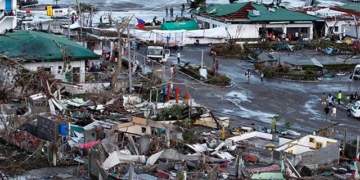Europe is warming faster than any other region in the world, increasing the risk of wildfires and floods.
According to the annual summary report from scientists at the Copernicus Climate Change Agency and the World Meteorological Organization (WMO), Europe experienced its hottest year on record in 2023, highlighting the alarming future of a continent that is warming the fastest in the world.
Europe witnessed the largest wildfires ever recorded last year, as well as some of the most devastating floods in history.

Residents witness a wildfire near Sikorrachi village, Alexandroupolis, Greece on August 23, 2023. (Photo: Bloomberg).
Europe Warming the Fastest
The report indicates that 2023 was one of the hottest years ever recorded in Europe, caused by climate change and the El Niño weather pattern. Extreme temperatures have increased wildfires in the region. The area of forest burned last year was equivalent to the total area of London, Paris, and Berlin combined.
Among these, Greece recorded the largest wildfire ever in the European Union (EU), with 960 km2 burned, which is double the size of its urban area of Athens.
According to WMO data, the global average temperature in 2023 was 1.45 degrees Celsius higher than pre-industrial levels. The warming temperatures led to heavy rainfall. All of Europe experienced about 7% more rainfall than normal.
In August 2023, Slovenia was devastated by flooding that caused billions of euros in damage, becoming one of the worst natural disasters for an EU country.

The town of Ravne na Koroskem in Slovenia submerged during the August 2023 flood. (Photo: CNN).
According to Samantha Burgess, Deputy Director of Copernicus and one of the authors of the report “The Climate Status of Europe,” the report paints a troubling picture for the continent, as carbon dioxide and methane emissions in the atmosphere continue to rise, while the rate of warming in Europe is around 0.4 degrees Celsius per decade, double the global average.
“As air temperatures and greenhouse gas concentrations in the atmosphere continue to rise, we will continue to witness extreme weather events that are becoming more frequent and severe,” Burgess stated. “Therefore, we may continue to see more records until we stabilize the climate and achieve net-zero emissions.”
Europe is projected to adapt to higher temperatures faster than any other region, particularly in areas close to the Arctic, such as Greenland, which is warming the fastest.
The entire continent will face warming of 3 degrees Celsius, even if the world succeeds in limiting global temperature increases to that level. The impacts will be most apparent in areas like the Alps, where glaciers have lost 10% of their remaining volume in the past two years.

Temperatures in some areas of Europe nearly reached 50 degrees Celsius during the peak of the heatwave on July 23, 2023. (Photo: European Space Agency)
Positive Signals
Although human-induced greenhouse gases are the main factor driving global temperature rise, the unusual increase in Europe is partly due to warmer ocean currents and the atmosphere. Meanwhile, regulations aimed at cleaning the air also remove heat-reflecting particles from the atmosphere across the continent.
In 2024, Europe may see some positive signals as El Niño shifts to a more neutral state or even a cooler La Niña event.
More extreme weather is also helping to boost Europe’s potential for renewable energy production due to strong winds in late fall and increased river flow for hydropower. A record amount of clean energy was produced last year, with nearly half coming from renewable sources.
The Copernicus program uses billions of measurements from satellites, ships, aircraft, and weather stations around the globe for monthly and seasonal forecasts. Together with the European Space Agency, Copernicus plays a central role in the EU’s €16 billion effort to combat climate change through accurate forecasting. This is the first time this program has collaborated with the WMO to produce this report.
New scientific reports will call for stronger efforts to cut emissions both domestically and internationally.
Currently, the EU is deviating from its goal of reducing CO2 emissions by 55% by the end of the decade. Polls show support skewing toward skepticism about the effectiveness of climate change action ahead of the upcoming European Parliament elections in June this year.




















































